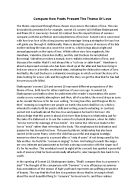In ‘Sonnet 116’, the poet talks about the constancy of true love – it can’t be “shaken” even when people get older and lose their “rosy lips and cheeks”. He sees these physical attributes as unimportant as true love is the “marriage of true minds” – two thinking willing individuals who aren’t driven by emotions or hormones. He presents relationships using nautical and time imagery. He says that true love “looks on tempests”. This implies that true love is reliable as it guides us in an uncertain and stormy world – life isn’t always easy. The use of the word “tempests” describes the difficulties love has to endure. The poet knows that life will eventually end – “within his bending sickle’s compass come”. He personifies time to make the battle between love and time more dramatic. He says that all time gives us is “brief hours and weeks” but true love survives to the end of time, “even to the edge of doom”. True love isn’t at the mercy of time because it has no end. The poet presents the relationship as undying as true love doesn’t change when circumstances change, if the love is real love, it would remain just as intense as it was.
In ‘Funeral Blues’, the speaker mourns his deceased lover – he wants to “stop all the clocks”, an impossible distress that shows his utter distress. With his lover gone, the speaker believes he commands all happenings – “cut off the telephone”. He feels that everyone should join him in his mourning by allowing the “mourners to come”. He feels that everyone should share his grief and everything should just cease now that his lover has gone. The relationship is presented as close as the deceased lover was important to the speaker. The lover was “my North, my South, my East and West” which shows he was everything to the speaker which shows this closeness. The reader realises the significance of the lover to the speaker because “He is Dead”- the capital letters portray a close relationship. He believes his dead lover is worthy of a grand funeral – he re-iterates his desperate need for public mourning by asking the policemen to wear “black cotton gloves” and “crepe bows” should be put round the necks of doves. These things aren’t usually associated with mourning but this suggests his intimacy with his lover. The speaker also feels that life is meaningless – he asks kindly to “pack up the moon” and “dismantle the sun”. He wants the world to stop and disappear because he has lost someone he was very acquainted to. He cannot make a future for himself because of this tragic event and he feels “nothing now can ever come to any good”. The relationship is presented as a close, intimate one and the deceased lover was special to the speaker.
In “Soliloquy in the Spanish cloister”, the speaker is angry and jealous at a fellow member of the Spanish monastery – “hell dry you up with its flames!” The speaker rants about Brother Lawrence’s sins while he waters the plants. The reader can see evident jealously in the second stanza. The speaker talks about how Brother Lawrence, the ‘fellow’ monk, talks at the table which angers him. The speaker tells us of the “wise talk of the kind of weather” that he endures at the table. In truth, the speaker is jealous that Brother Lawrence is good conversationalist and mocks him using rhetorical questions – “What’s the Latin name for parsley?” The speaker goes even further to mock his love for good food and accuses him of supposedly ‘lusting’ over the nuns washing their hair outside the convent – “Can’t I see his dead eye glow”. The speaker wants to catch him in the act which suggests that there is no evidence for this accusation. The speaker presents himself as a righteous man and talks about how he crosses his silverware “in Jesu’s praise” and Brother Lawrence doesn’t, drinking his orange juice “at one gulp” to denounce the holy trinity. The speaker plots a plan to trip Brother Lawrence into sin with his “scrofulous French novel” and considers selling his soul to Satan for the damnation of Brother Lawrence. The sins he accuses Brother Lawrence of are justified but the speaker is unknowingly guilty of each of them himself whereas Brother Lawrence is only guilty in the speaker’s head. The relationship is presented in jealousy and anger – Brother Lawrence is involved in the treacheries of the church and enjoys it more which makes the speaker jealous and fuels his anger but there are elements of hypocrisy in the relationship as the speaker is involved in those treacheries too.
The first stanza explains that he would wish to spend forever wooing and flattering her, the second that life is short and they won’t live forever and the third suggests that they should grab their pleasures while they’re still young and attractive. The poem follows a structure for a successful argument – if A, but B, therefore C. This structure suggests he is making a well-ordered argument but also shows his urgency. His sense of frustration is beginning to show through his humorous exaggeration and irony as he mocks his mistress’ romantic ideas about love. He refers to the “Indian Ganges” and “Humber”.








